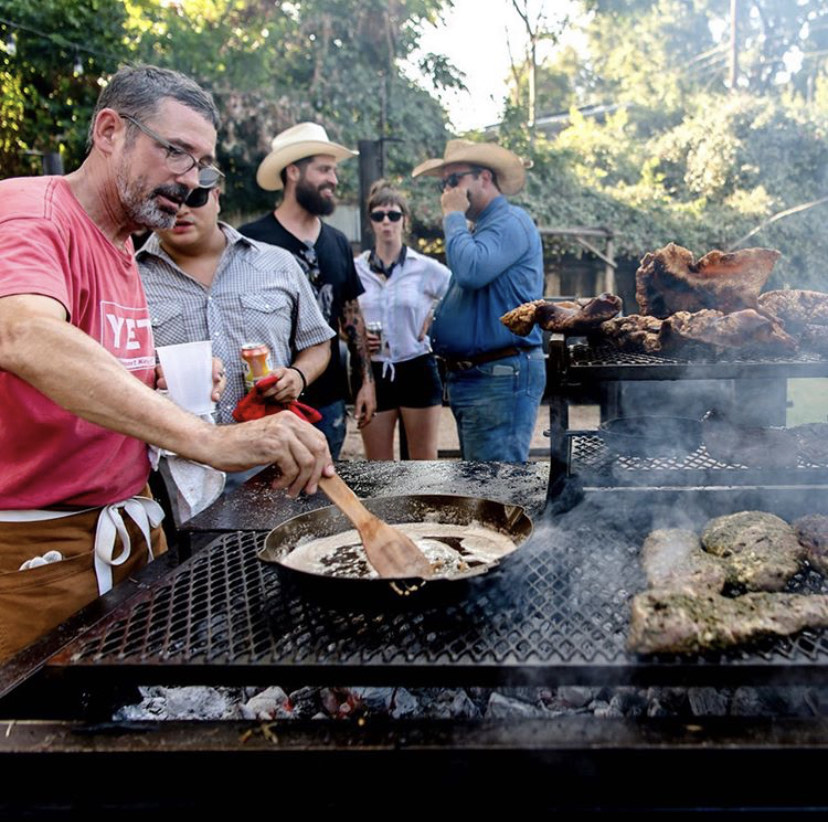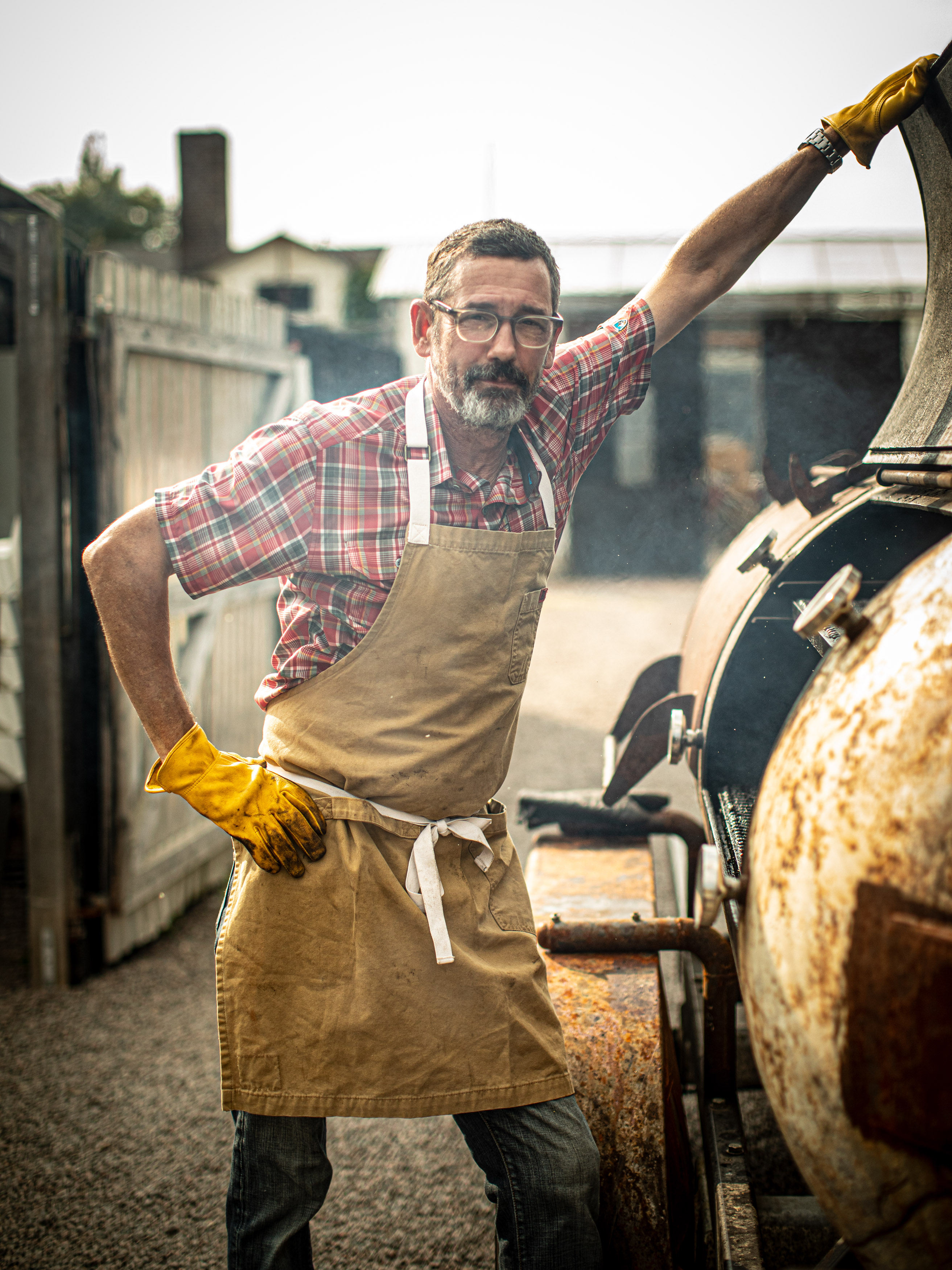“A lot of times I’ll say that the smell of barbecue is like this symbolic dinner bell and anybody who smells it — it’s inviting,” says legendary six-time world barbecue champion pitmaster and French-trained chef, Tuffy Stone. He’s not wrong. For me and my fellow carnivorous, barbecue-obsessed food lovers, just a slight whiff of fat-laden, fragrant smoke or sweet hickory barbecue sauce signals a feast.
Stone, a Virginia native and Barbecue Hall of Fame inductee, is also the author of Cool Smoke: The Art of Great Barbecue. In that cookbook, the chef and pitmaster shares many of the nuanced techniques that help him create perfectly tender and sumptuous cuts of meat.
“Everything is so fast and immediate in this day,” he says. “No one’s waiting for a letter in the mail, unfortunately, anymore. It’s a text. It’s a post. It’s a call. It’s a tweet. And I think barbeque is one of these moments where you take a pause, you slow down, you’re taking affordable ingredients for the most part, and trying to make something special out of it.”
Tuffy’s specialty is pork and whole chicken, which is what he told me he wants to be known for when we met in one of the barbecue capitals of the world, Austin, Texas. During our time together, I was completely blown away by his enthusiasm and love for the art of smoke and flame. The food itself was even more impressive.
Check out our full conversation below, along with a Tuffy-approved recipe for delicious barbecue pork. Enjoy!
https://www.instagram.com/p/CObor4PngNT/
What motivates you as a pitmaster?
I’m a little different. I started off in a French kitchen. I started learning how to become a chef back in 1987. It was 2004 [when] my wife and I had started a catering company and, in the company, had grown to a point where I was managing the business more than I was cooking. And I needed a new culinary activity to kind of reconnect me as a cook and a chef and learning how to cook with all wood burn and fire became like this idea in my head of what I was going to learn next.
It was such an amazing journey. I often say that that barbecue is like the most gregarious cuisine. It’s the friendliest food. Barbecue is something that historically is feeding large groups of people – family reunions, picnics, and things like that. It’s usually taken modest cuts of meat, tough cuts of meat, and trying to cook something great out of it. I think because of my culinary background, I thought, “Man, I should be able to get the knack of this. I can make all these hard-to-pronounce fancy expensive foods. I can make barbecue.” I got my first pit back in 2004 and got a load of hickory, got some pork butts, made a rub, fired up the pit, seasoned this meat – and I just ruined a big ol’ load of meat. It was so humbling, but it was so exciting.
I say it a lot of times — I went off the barbecue deep end. There are so many things about barbecue that are interesting to me. It’s such an approachable food. Nobody’s ever afraid to pronounce it. I can be driving down the road and my pit is on the back of the truck and a car will pull up beside me and give me the thumbs up. I think that’s what barbecue does for so many people but really, I think it’s more of a challenging cuisine. I’m, of course, much better at it today than when I started but that took a lot of mistakes and a lot of learning.
I think it’s a combination of building a fire and taking a tougher cut of meat and taking it to a level that just puts a smile on people’s faces. It’s the process. You’re a writer and I just saw you did a review on bourbon. So, we have something in common there. (Laughs) I’ve written a cookbook and I talk a lot, but I think if writing was my full-time profession, it would be finding the stories that are not only interesting to you but hopefully interesting to the reader.
I think food is that way. I read a cookbook one time and it was a Michelin three-star chef who had written his cookbook. He said he didn’t believe you could cook a dish as well as it could be cooked if you weren’t kind of a little bit passionate about that. It’s probably true with writing, too. I’m sure you can write the story, but probably your most magical stories are the ones that you feel a connection to – and I think it’s the same with food.

Perfectly stated. I agree with your comment on being passionate about topics. That’s exactly why I only cover certain brands or certain types of music, because if it doesn’t resonate, it will reflect in the writing or in your case, reflecting in the cooking.
I like the fact that you write about the things that connect with you and you feel good about. There’s so much clutter out there in this world. I think finding things that are authentic is always refreshing.
Thank you. You brought up several good points, but I’m still thinking of the first pork butt that you ruined. Would you say that you now have that mastered? What’s your signature dish?
Well, so let’s talk about why that pork was so bad. My next-door neighbor, Sue Brown – who’s still my next-door neighbor – was a recipient of a lot of my failed attempts in barbecue. Most barbecue becomes not great when it’s not cooked to a nice tender. The other thing is, most people when they make barbecue initially, they over-smoke it. I read a book by author John Willingham. Unfortunately, he’s passed, and he wrote in his book some things that really stuck with me. He said smoke is dirt. We’re cooking, we’re not smoking. So the way I say it now is I like to treat smoke like salt and pepper. With Texas barbecue, especially where you live, smoke is certainly an element to the barbecue as I know it in Texas; but you don’t want it to be so smoky that that’s all that you taste.
With my initial attempt at barbecue, I was over smoking, and I wasn’t getting the tenderness right. One day, I knocked on Mrs. Brown’s door, and I had some more barbecue for her, and she said, “Tuffy, thank you, but I still have some of the last barbecue you gave me.” It struck me right then and there: She didn’t want it because it wasn’t any good.
Over time, as I got better at learning how to run a fire and cooking barbecue, I did kind of go back to my roots, like my French training. I don’t do French barbecue, by any means, but I try to treat [barbecue] with a lot of finesse, and I try and really execute it well.

So, if I wanted to make the best pork ever, what would be the one piece of advice you would give me towards how I cook it?
Oh, it can’t be one. I mean, if it’s going to be one, I think the best barbecue and really the best foods in the world – and I don’t care if it’s Caesar salad or ice cream or pork butt – is hitting this magical texture this magical tenderness. You say, “Well, how does that apply to Caesar salad?” I think the best Caesar salad has the [crispest] romaine, the crunchiest croutons, dressed just with the right amount of dressing – not too much, not too little. I think the best ice cream has the best mouthfeel and we could probably go into bourbons and the texture of how it can feel in your mouth. Barbecue pork is about getting this magical doneness to where the meat was cooked until it was tender, but it’s not overcooked. It’s not chewy, it’s got like a silky gentle chew with that fat rendered out during the cooking process.
If I only focus on one thing and give you one answer, I think it’s going to be focusing on tenderness. That’s huge.
So can you take us through the steps to the perfect pork butt? [Numbers added after the interview for clarity.]
- Take a pork butt, season it for seven hours before you’re going to smoke it. I got tons of recipes for rubs on my website. The rub can be as simple as salt and pepper and it can be something you buy at the store, it can be something you order on the internet, but most rubs have salt in them. So where I come with my time is I don’t want that rub to not be on there long enough and I don’t want it to be on there so long that it cures the meat. So typically speaking, I would say basically seven to eight hours or overnight for writing purposes.
- Get up in the morning, pull your pork butt out and let it sit at room temperature for one hour while you get your grill or your smoker prepared.
- Get it at 275 if you’re on a gas grill because I’m not going to be persnickety that way. People have what they have that they’re going to cook on. So, if you’re going to cook on gas, you want to do what’s called two-zone where you have one burner on and one burner off, you’re going to put that seasoned piece of meat on the side where the burner’s off so that we don’t burn it up. If you’re doing a charcoal grill, you will have coals on half of the bottom of your cooker, and then not on the other side. If you’re in Texas and got a big ol’ Texas offset, then that doesn’t matter.
- We’re going to cook it indirectly for four hours, and after one hour, we’re just going to mist it with a little bit of apple juice just to kind of keep it hydrated during the cooking process. So, cooking 275 for four hours. After the first hour, I mist it with apple juice and then mist it every 30 minutes. After four hours, I got beautiful color, I got just the right amount of smoke.
- Then, we’re going to do what’s called the Texas Crutch. We’re going to wrap it in aluminum foil and put it back on the cooker to continue to cook until it’s tender. Probably check it two and a half hours later as a start. We’re going to cook that pork butt until it’s about 195 degrees or until it probes tender with a meat thermometer.
- Pull it off the cooker, let it rest for about an hour or hour and a half. And then, we’re going to chop it, pull it, slice it – whatever you want to do and serve it with a favorite barbecue sauce.







